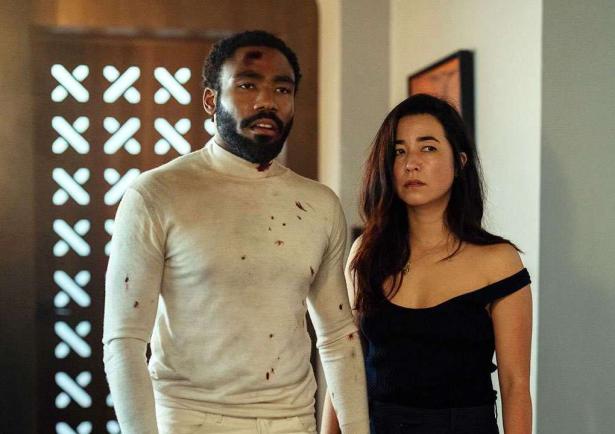The eight episodes of Mr. & Mrs. Smith, the new Amazon Prime remake of the 2005 Brad Pitt–Angelina Jolie hit movie, play at such a slow tempo, it’s as if you’re watching an experimental attempt to serialize an already-overlong indie art film and foist it on an unwary public.
Whether you can endure what is essentially the injection of action and comedy into something like Noah Baumbach’s Marriage Story (2019) might depend on how much you like the lead actors, Donald Glover and Maya Erskine (PEN15), both of whom are versatile, compelling performers. They play misfit unemployables who apply for jobs as assassins and find that the hardest part of their dangerous new lives as John and Jane Smith isn’t the body count — it’s having to pretend to be married. The astonishingly good supporting cast helps too — it’s an unexpected pleasure to see colorful appearances by Paul Dano, Parker Posey, John Turturro, Alexander Skarsgård, Sharon Horgan, Sarah Paulson, Ron Perlman, and other notable talents.
Created by actor-singer-writer-producer Glover and Francesca Sloane, his fellow writer-producer on Atlanta, Mr. & Mrs. Smith is using the action-comedy genre as a way to represent how impossible life is now for so many people, which is a pretty good idea. So we recognize the dehumanizing process of the entirely computerized job interviews our two lead characters go through separately — sitting in a dark booth typing in anxious answers to more and more intrusive questions and having to submit fingernail clippings in tiny plastic bags to a small slot that opens up before them.
The new hires are told to cut all ties to their families and significant others in order to take up their new lives. They do so without hesitation and arrive at their suspiciously opulent new home, where they find out, as part of their instruction packets, that they’re pretending to live there as the married Smiths while they await instructions for their first mission. Awkward! But on the other hand, it’s wonderful to have income and housing and sudden social status and all the other inducements to do whatever they’re told.
Clearly this is a very different narrative and tone from Doug Liman’s Mr. & Mrs. Smith, which was a posh fantasy designed to be a two-star vehicle about a gorgeous suburban married couple who are bored and disaffected because each doesn’t know the other is actually a slick, glamorous assassin — even though it was obvious they both had to be slick, glamorous somethings, because just look at them.
This new version of Mr. & Mrs. Smith features attractive leads who can nevertheless be accepted as ordinary fuckups in a deeply dysfunctional culture. In such an alienating environment, people feel freakish even when they’re only a little offbeat. As the Smiths get to know each other and become mutually attracted over the course of several episodes, the rather uptight and controlling Jane reveals that she’s considered to be a sociopath whereas John has interiorized a sense of himself as hopelessly weak and incompetent. He feels deeply ashamed of the fact that he loves his mother and, though it’s forbidden by the assassination program, he’s maintaining contact with her. Perfectly ordinary traits are pathologized, making John and Jane’s terrible insecurities, both economic and emotional, a driving factor in everything they do.
In one of the best episodes midway through the series, John and Jane meet another pair of “Smiths” (Posey and Wagner Moura) also hired as assassins and pretending to be married, but who then wound up in an intense romantic relationship. But they’re much more experienced and sophisticated and better paid. Soon the younger couple are currying favor with the older, cooler, richer couple, desperate to be liked. This involves a long night of bragging and expensive carousing and, in the end, foolishly agreeing to go along on a “highest risk” mission as a foursome.
It’s no surprise that one entire episode late in the series, entitled “Therapy: Naked and Afraid,” will involve couples counseling. The breakdown of John and Jane’s relationship, as both romantic and work partners, and the way they’re racking up failed missions without knowing what their employer will do to them if they hit three failures, makes the series turn ever darker as it goes along.
So at least the series is something a little different, a little offbeat, like John and Jane. As for the cruelly slow pacing in some episodes, that might really be evidence of widespread pathology in the entertainment industry.
You’ve noticed it, haven’t you? So many films and television series that are so much longer and slower than they used to be, right up to the edge of what you can sanely tolerate? Makes you feel like you’re part of some sort of malevolent social experiment by the powers that be, right? What do you think it means for all of us working Smiths out there?
SHARE THIS ARTICLE
CONTRIBUTORS
Eileen Jones is a film critic at Jacobin, host of the Filmsuck podcast, and author of Filmsuck, USA.
Our new issue, on AI, is out now. Subscribe to our print edition today.


Spread the word